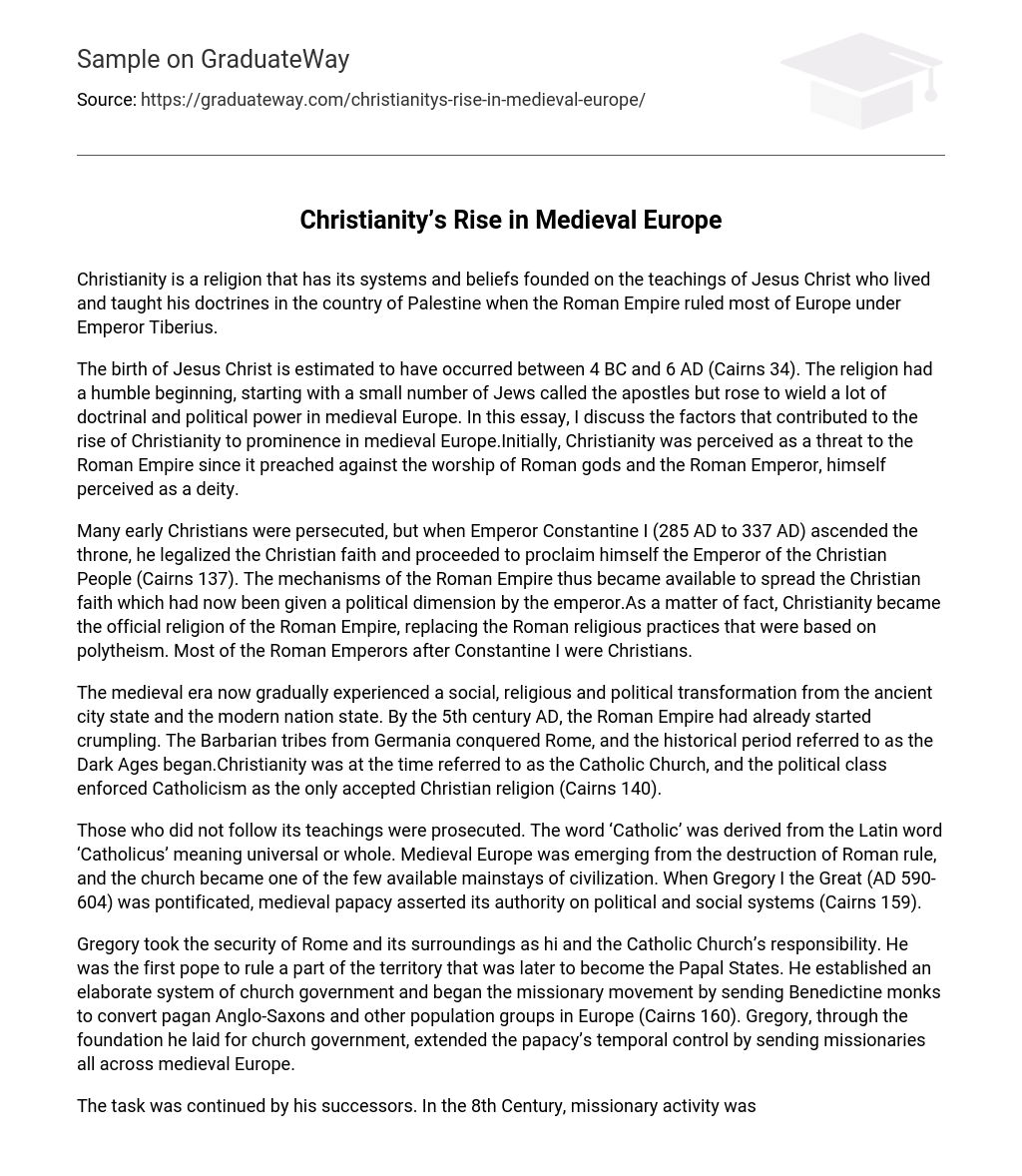Christianity is a religion that has its systems and beliefs founded on the teachings of Jesus Christ who lived and taught his doctrines in the country of Palestine when the Roman Empire ruled most of Europe under Emperor Tiberius.
The birth of Jesus Christ is estimated to have occurred between 4 BC and 6 AD (Cairns 34). The religion had a humble beginning, starting with a small number of Jews called the apostles but rose to wield a lot of doctrinal and political power in medieval Europe. In this essay, I discuss the factors that contributed to the rise of Christianity to prominence in medieval Europe.Initially, Christianity was perceived as a threat to the Roman Empire since it preached against the worship of Roman gods and the Roman Emperor, himself perceived as a deity.
Many early Christians were persecuted, but when Emperor Constantine I (285 AD to 337 AD) ascended the throne, he legalized the Christian faith and proceeded to proclaim himself the Emperor of the Christian People (Cairns 137). The mechanisms of the Roman Empire thus became available to spread the Christian faith which had now been given a political dimension by the emperor.As a matter of fact, Christianity became the official religion of the Roman Empire, replacing the Roman religious practices that were based on polytheism. Most of the Roman Emperors after Constantine I were Christians.
The medieval era now gradually experienced a social, religious and political transformation from the ancient city state and the modern nation state. By the 5th century AD, the Roman Empire had already started crumpling. The Barbarian tribes from Germania conquered Rome, and the historical period referred to as the Dark Ages began.Christianity was at the time referred to as the Catholic Church, and the political class enforced Catholicism as the only accepted Christian religion (Cairns 140).
Those who did not follow its teachings were prosecuted. The word ‘Catholic’ was derived from the Latin word ‘Catholicus’ meaning universal or whole. Medieval Europe was emerging from the destruction of Roman rule, and the church became one of the few available mainstays of civilization. When Gregory I the Great (AD 590-604) was pontificated, medieval papacy asserted its authority on political and social systems (Cairns 159).
Gregory took the security of Rome and its surroundings as hi and the Catholic Church’s responsibility. He was the first pope to rule a part of the territory that was later to become the Papal States. He established an elaborate system of church government and began the missionary movement by sending Benedictine monks to convert pagan Anglo-Saxons and other population groups in Europe (Cairns 160). Gregory, through the foundation he laid for church government, extended the papacy’s temporal control by sending missionaries all across medieval Europe.
The task was continued by his successors. In the 8th Century, missionary activity was peaking. English missionaries went to France and Germany establishing the system of papal government existing in Rome and England. Papal States were established and the pope’s temporal power was greatly enhanced (Cairns 188).
By spreading Christianity, the missionary movement that was widespread in the early middle ages facilitated the fusion of Germanic and classical cultures, and the church became a haven for people seeking contemplative lives and opportunities for becoming scholars.The Catholic Church had its own laws and imposed taxes on its lands. It also received numerous gifts from people wanting special favors and certificates it issued guaranteeing places in heaven (Cairns 175). It wealth therefore grew enormously, and so did its power and influence.
It thus influenced kings and rulers in medieval Europe to recognize it as the official religion, and those who opposed its teachings were excommunicated. Through these mechanisms, the Christianity rose to prominence in most parts or Europe.





